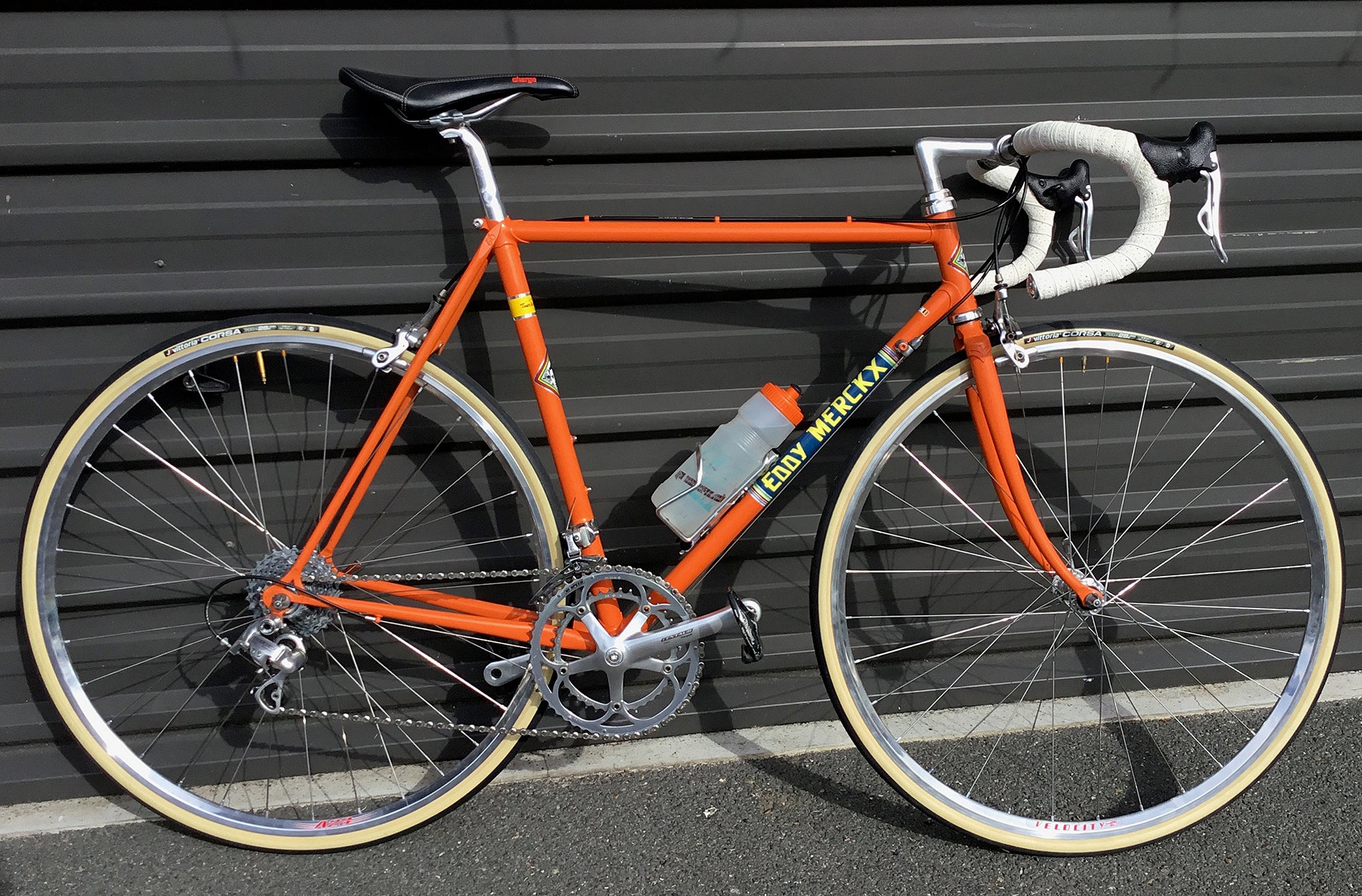
I came by a racing bike a couple of summers ago. An almost new, ridiculously light, state of the current art, carbon fibre framed machine festooned with the best Japanese equipment, comfy and extremely functional. I didn’t like the look of it, but it was nice to ride. The brakes and drivetrain were faultless, it handled perfectly, and as I mentioned, it was light. Every time I picked it up I marvelled at it. I am pretty sure my last track bike weighed about the same.
But even after several thousand kilometres on the thing, I never loved it.
So when a mid-nineties example of an Eddy Merckx steel frame was brought to my attention, I put the carbon rocket on TradeMe.
Transactionally, it was a neat swap: I got almost exactly the same amount for the carbon bike as I paid for the Merckx, which came with a generous helping of early 2000s Campagnolo running gear thrown in by the vendor for a small extra consideration.
As an aside, when the incomparable career of Eddy Merckx came to a close, he set up a business making bikes.
Unlike a lot of other racers who licence their name to a bike factory, Eddy wanted to actually build them himself.
When he started it was still in the era of steel racing bikes, and his factory was established in Belgium under the tutelage of Ugo De Rosa, the craftsman who built most of Eddy’s racing frames.
The factory employed many of Eddy’s racing team mates, and has supplied bikes to many pro teams, first steel, then alloy, and these days carbon fibre.
If you grew up cycling in the seventies, Eddy Merckx was a god. There were no reports of cycling in the local news, so we got our information about races several months after they had happened.
The bike magazines, when they finally got here, were full of Eddy’s exploits. He raced year round, on the road - where one season he won more than half the races he lined up for - on the indoor tracks during winter, and even in cyclo-cross events. His bikes, which were simply unavailable even if you could have afforded them, were icons of a world we were so far away from it might as well have been another planet.
But still we lusted after them.
And now, forty years later, I had one.
It is approximately 25 years old, but painted and decalled by a previous owner, at some point in its life, to resemble one of Eddy’s racing machines of the seventies. And while the Campagnolo groupset is an another anachronism, it is silver aluminium like the seventies kit, and looks the part. I wanted a bike to ride, and genuine vintage kit would be hard to find but more importantly, hard to ride. Modern stuff definitely works better, and even 15 year old gear works much better than the older stuff. The ten speed drivetrain has enough ratios to help me clamber up hills I may have been walking if I had installed a period 6 speed system.
I was humbled by the assistance of many people from all over the place once word got out that the project was underway. Kah Hoe Chan made the initial contribution by selling me the bike, and the Campag gruppo. David Benson came up with an Italian thread bottom bracket almost immediately. Chris Tennent Brown supplied a period Cinelli stem unintentionally, I think. Our piles of stuff have intersected at various times and I am not absolutely sure when or how the stem came into my possession. Jeff Anderson adjusted the seatstays, which were strangely out of whack, and supplied NOS Suntour dropout screws. Oli Brooke-White supplied the crankbolts, and the correct nut for the front brake mount bolt. Saul Webb procured the polished rims and rebuilt the wheels off my Benson. Dean Cameron from WideOpen came up with an IDB clamp for the braze-on version of a matching front derailleur given to me by Carolyn Scherger, after I hamfistedly snapped the clamp on the derailleur that came with the bike. Carolyn also donated a shopping bag full of old Campag detritus that included some tools, all the better for adjusting the very flash Campag headset foolishly bought and delivered to my house courtesy of Brett Tennent Brown. He lives in Australia and uses my house as a depot for bits and pieces he buys, and the headset was too nice for me not to install in the Merckx. I swapped it for a hoodie. I paid for the derailleur clamp from WideOpen and a very nice Campag seatpost from Kaspar Cycles, and also bought a new chain, cables and some bar tape. The Cinelli 64 bars came off a donor bike hanging in the shed.
When I got it together I was amazed by how tight the spacing was on the rear tyre above the rear brake mount. Even more amazed when I took a spin down the driveway and the weight of me on top of it cause the tyre to actually rub on the brake bridge.
The bike was immediately dismantled and taken to Jeff Anderson, who rebrazed the brake bridge 5mm higher up, did a bit more jiggery with the alignment of the seatstays, and put me in touch with some guys who mix paint to match and supply in a rattle can.
By the time Jeff had finished with the frame adjustment I had the paint. Jeff sprayed it on, and baked it with his welding torch while I waited. It matched very well, and the fairly industrial finish achieved matches the similarly spartan paint job on the rest of the bike. Like a lot of bikes from the era, the paint is simple orange enamel, and the stickers are screen printed on silver foil. Very basic, and simple to do.
Jeff installed the new headset, and I put it back together.
The last pieces to finish it were new brake hoods and some deluxe 28mm Vittorias which I swear look so much like Clement tubulars that I get nostalgic for evenings spent gluing on tyres four decades ago.
I look forward to riding this bike a lot, for as long as possible.

